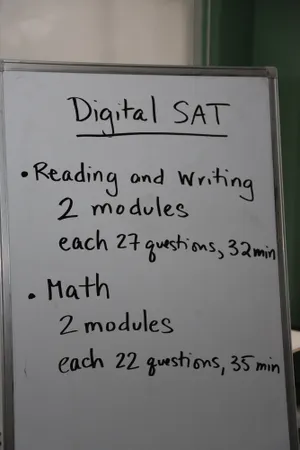Big changes are coming to the SAT, and not everyone is happy. What students should know.
Last fall, a junior named Mia approached Candice Mackey with an unusual request: She wanted to take the SAT – typically administered at her school in the spring – a few months early. Mia was one of several juniors to broach the idea with Mackey.
Mackey coordinates testing at the Los Angeles Center For Enriched Studies (LACES) and is also the public magnet school’s only college counselor. Normally, she’d discourage her students from taking the standardized exam prematurely. She’d want them to fulfill their maximum potential, to pack in as much test prep as possible before they take the high-pressure (if now largely optional) assessment.
But this time, she understood the students' concerns: Starting in March, the SAT will be digital. The traditional paper-and-pencil format is no longer available, with rare exceptions for students with visual impairments, severe reading disabilities or other documented challenges.
Mia, who asked to use her first name only to avoid harming her college prospects, said she has eye problems and gets headaches when she stares at a screen for an extended period. The materials she’s been using to train since middle school, including Preliminary SATs (PSAT) and practice SATs, were almost always in paper format. There are relatively few digital prep materials.
Other students expressed similar concerns, Mackey said.
“They felt an urgency ... to take the paper exam,” she said, knowing that they won’t have that option anymore.
The new format comes amid fierce debates over whether colleges should consider students’ race in admissions, and after some colleges reinstated the test score requirement. High schools are also scrambling to help teens navigate other changes, such as the bumpy rollout of the new federal financial aid application.
Some say the new SAT could make college admissions even messier.
The College Board, the organization that administers the SAT, believes digitization is for the better – that societal changes demand the modern format and that students are ready and eager to enter a new electronic era. Educators, test-prep experts and youth advocates, however, are worried the digital rollout could make the admissions process more precarious. They say many students, especially those without the means or savvy to keep up with the latest developments, are ill-prepared for what's to come.
“This past year, a lot of big changes have happened too quickly,” said Diane Barnett, a consultant with the online education provider Knovva Academy, which helps students get into elite schools. “Some students’ heads have been spinning from that.”
How is the SAT changing in 2024?
The digital SAT launched internationally last year, and the digital PSAT debuted in the U.S. last fall. The final stage of the College Board’s digital shift happens this spring when students in the U.S. will take the SAT using their personal or school-provided laptops or tablets, via an app called Bluebook.
While the College Board says the scores will be comparable, the new exam isn’t just an on-screen version of the paper-and-pencil test from years past. Test takers will experience something fundamentally different in several ways.

A key change is that the new test is what the College Board describes as “adaptive” in nature. Both the math and reading sections will be divided into two parts. A student’s performance in the first part of each section will determine the difficulty level of the second part that shows up on their screen.
The second half of the test will either be harder or easier than the first half, depending on a student's performance. If a test taker breezes through the first half of the math questions, the second half of that person’s test be more difficult. For a test-taker who struggles during the first half, the second half will be easier. In both scenarios, a person’s scores will be calibrated based on the questions’ difficulty.
This system benefits students who have studied, are good at test-taking and are unintimidated by difficult questions. And psychologically, test-prep experts say, it could benefit students who are prone to botching their performance when faced with questions too hard for them because they'll perform better with a second set that’s more manageable.
But the adaptive functionality could disadvantage others, educators say, like students who simply have bad luck with the first half and are forced into getting to a lower-than-expected score because they won’t get as many points with an easier second half.
Adaptive testing allows the College Board to more quickly assess what an individual is capable of – it doesn’t waste time asking the student questions that are too easy or too hard for their performance level.
That efficiency allows for the second major difference in the digital SAT: At a little more than two hours, it’s roughly an hour shorter than the last iteration, which was launched in 2016. With the digital SAT, students will get more time per question. Math questions will be explained more concisely than before, and reading passages will also be shorter.
The format works better for testers, said Priscilla Rodriguez, the College Board’s senior vice president of college readiness assessments. The organization ran pilot programs, she said, and “what students are telling us is … they feel less tired, less rushed and less freaked out.”
SAT is going digital:Exam will be online-only, shorter as colleges ditch standardized tests
SAT registration deadline is coming up, but lots of students unaware of changes
The deadline to register for the March SAT is in just a few weeks, on February 23.
“It’s not on everyone’s radar,” said Knovva Academy’s Barnett. “A lot of kids … are really going to be surprised by it and have not had time to practice that calculator in the app or to figure out how to get their own (device). And that will adversely affect them.”
The College Board first announced the move to digital two years ago. It has partnered with Khan Academy, which provides free online learning resources, to disseminate materials and help students prepare for the digital SAT. The College Board also provides four free full-length digital practice tests via its Bluebook app.

Rodriguez feels confident that word has spread far and wide and assured that the exam will continue to improve to meet applicants’ needs.
“My hope is that students who are about to engage with this new SAT … know what to expect, they know what’s coming; they know it’s shorter, they know how to practice,” she said. “Given this is a test that can open up a lot of doors for them, it might as well be the best possible test.”
Still, counselors say news about the digital-only test likely hasn’t reached many students, especially those who live in rural or high-poverty communities and have less access to people in the know. Some may have missed getting the information from someone on campus given there are, on average, more than 400 students for every school counselor in the U.S.
The rationale for changing an admissions exam
Mackey, at LACES, says the benefits of the new format are evident, at least for people like her who will administer it.
The traditional exam necessitated piles of paper materials being shipped to schools or centers and locked up before test day, a cumbersome process that allowed would-be cheaters easier access to booklets beforehand.
With the digital format, students will take the exam on their own devices, and each test taker will see a unique sequence of questions, making it more difficult to cheat.
Many educators are optimistic because the new test takes into consideration accessibility issues and students’ well-being. The fact that it’s shorter and adaptive makes it less stressful for students, Rodriguez said, particularly people prone to exam anxiety or students at under-resourced schools who have had learning gaps that were compounded by the pandemic.
The shorter prompts make the 2024 test more manageable for students who are learning English. The app and the built-in calculator students can use on the math questions feel more intuitive to a digital-native generation, according to some educators and students.
Lujain Malash, 17, a high school senior in Egypt who has taken the digital SAT several times, disliked that her performance in the first half determined the difficulty level of the second. “It’s a little complicated,” she said. “The worst part is that depending on how you do in the first part... if you don’t do well you don’t end up with a really good score.”
But Malash, who spent part of her childhood in France and speaks multiple languages including English, said the shorter length makes it worth it. As someone who prefers math over reading, the briefer passages are “more relaxed” than the longer, paper-format ones she engaged with in tutoring sessions. She also valued being able to practice with the Khan Academy materials.

While the digital exam may be more convenient and secure, Mackey and other observers say those improvements could make success more uneven as it’s rolled out.
Admissions tests have long been criticized as being a better measurement of students’ wealth than of their competence or potential. Since so much of the exam necessitates strategies such as intelligent guessing and time management, teens with the means to enroll in expensive test prep services are better equipped to score well than students who are just as smart but haven’t had the time or resources for practice.
“Practice makes perfect – there is something to that,” said Charles Lang, senior executive director of the Digital Futures Institute at Columbia University’s Teachers College. “Getting a scenario that you can practice in that is as similar to the actual event is a very important factor” in achieving a high score. He said it’s problematic that the College Board is pitching this new test’s scoring system as essentially the same as the old one’s: “I don’t think it’s quite as straightforward as they’re painting it.”
Are SAT scores fair? New exam faces ongoing equity concerns
Some College Board skeptics, like Akil Bello of the advocacy group FairTest, say the digital SAT doesn’t do anything to address the exam’s inherent inequities and may make student performance more uneven.
“Theoretically, digital testing is better; theoretically, (the College Board has) prepared schools and provided guidance,” Bello said. “But I’m concerned about the practical realities and the differences between what your ideal school has and what the common school has.”
On a basic level, people need technology to take the new test.
The exam requires that each student have a device and reliable broadband. Two-thirds of students take the SAT on campus during class time, and many students use devices provided by their schools, but huge gaps remain in terms of which districts have access to adequate infrastructure for administering the new SAT.

What happens if, say, a rural school has faulty broadband service and there’s no IT person on staff on a day when troubleshooting is needed? What if a student doesn’t have consistent access to a device on which they can practice, that comes with the app downloaded on it?
Judy Henriquez, the director for career and college counseling at the Bronx Center for Science & Mathematics (BXCSM) in New York City, said the Chromebooks provided by the school can be unreliable and students can have unstable internet access. Because of the issues, many teachers choose not to do computer-based testing in their own English language arts and history classes, for example.
Ama Oduro, a 17-year-old senior at Henriquez’s school, said she frequently struggles to sign in or access assignments on the Chromebooks. The malfunctions suck up a lot of class time. Even if the school manages to troubleshoot problems that arise on a test day, and the new format doesn't require a continuous connection to proceed, a flustered student might struggle to concentrate for the rest of the exam. Oduro, who took the traditional SAT last year, opted not to send in her scores when applying to colleges because she felt her test scores showed her in a poor light.
“Certain people who are not built for testing are, in a way, excluded,” she said.
If students can’t get a testing device from their school, the College Board says it will send a loaner to the campus. But navigating an unfamiliar computer can be overwhelming and glitchy for anyone, educators noted, especially for someone taking a stressful test. Plus, these students would need to request a device at least a month before their test day. The deadline for that will soon pass for students taking the upcoming exam.
Others are concerned about the adaptive nature of the assessment. There’s little clarity about how the change-as-you-go tests will be scored or about the implications of the adaptive model for applicants.
“My number one concern about going digital is that there’s not an option to have it on paper as well,” said Mackey, the educator in Los Angeles. “I'm not opposed to digital – I just don't think that it is in the best interest of students to only have it in that format.”
Is the SAT making a comeback in college admissions?
Since the pandemic, the vast majority of colleges no longer require applicants to submit standardized test scores. The trend toward deemphasizing the SAT began before COVID-19 and it became the default policy when circumstances made access to in-person exams difficult.
Fausto Rivera, a 17-year-old senior at BXCSM, is grateful colleges are less interested in test scores, which he sees as a misleading and unfair “way to analyze students’ potential and … control students’ future.” Last spring, Rivera took the paper SAT, having never practiced because of his work and family obligations. He was curious about how he’d fare.

His score reinforced for him that the SAT was “not really measuring your capacity.” A student could be having a bad day. People who buckle under pressure or who can’t pay for expensive test prep seem fated to perform poorly on the exam, he said. When Rivera heard the test was going digital, he didn’t feel inspired to retake it.
He thought the change was like putting lipstick on a pig.
“To me, it reflected the fact that they know there’s an issue but don’t really want to address it,” said Rivera, who’s already gotten acceptance letters to local public colleges and one private one but is now, like countless Americans, navigating FAFSA hold-ups due to a social security number error.
The new test may be vital for others.
A few schools are returning to the test requirement. Dartmouth on Monday became the first Ivy League institution to reinstate it. The Massachusetts Institute of Technology and Georgetown, which are Ivy-adjacent, already returned to requiring it for applicants. They’ve often cited research suggesting the scores are more predictive of college success than grades, which are sometimes inflated.
The College Board, meanwhile, is eager to remain relevant as it continues to compete with the ACT. The digital format is one lever for boosting its market share, according to Lisa Speransky, whose company, Ivy Tutors Network, works with students from a broad range of backgrounds. The ACT will offer a digital version beginning this year but it will continue administering the paper option as well.
Henriquez has embraced the fact that many colleges are distancing themselves from admissions exams. She has intentionally de-emphasized test prep when counseling her predominantly low-income students at BXCSM.
She saw how fixated they’d become on getting a good score, on how quickly they lost sight of the parts of learning she thinks truly matter – the essays where they could describe their passions, the after-school activities where they could explore new hobbies, the community service where they could help families like their own.
“They thought [the SAT] was the only way they could get into a ‘good’ school,” she said. “I hated what they were giving up.”
More changes to college admissions:What students can expect after Supreme Court’s ruling on affirmative action
Disrupting the fixation on the Ivy League, ‘elite’ colleges
Mia, the junior in Los Angeles, is “pretty good” with the score she got when she took the paper version of the SAT in December. She plans to take the digital exam at her school in March just to see if she can do better. "It's definitely a scary thing – testing," said. "It's like, people are saying they're test-optional, but the pressure is still on" to perform well.
Swaths of students, like Mia, still place immense weight on the exam even though it is largely optional at the most selective of institutions. Nearly 2 million high school seniors took the test during the last school year, the highest number since the start of the pandemic and just a hair short of the record rate – 2.2 million members of the Class of 2019. For comparison, roughly 2.5 million freshmen enrolled in a college or university in the fall of 2019, while 2.3 million enrolled in the fall of 2022.

Bello and others said the hullabaloo about the new SAT format distracts from a more pressing concern: students’ ongoing fixation on highly selective – or, as they put it “highly rejective” – schools. A majority of higher education institutions in the country accept more than half of their applicants. Only several dozen accept fewer than 30%.
“I worry about students who think that those top 10 or 15 schools are the only schools and that they won’t be successful if they don’t end up there,” Barnett said. “There is a school out there for everyone. It’s okay if you haven’t heard of it yet. It’s okay if it’s not what your parents want on their bumper sticker.”
Contact Alia Wong at (202) 507-2256 or awong@usatoday.com. Follow her on X at @aliaemily.
Disclaimer: The copyright of this article belongs to the original author. Reposting this article is solely for the purpose of information dissemination and does not constitute any investment advice. If there is any infringement, please contact us immediately. We will make corrections or deletions as necessary. Thank you.





